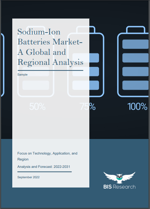Sodium-Ion Batteries Poised for Rapid Growth as an Alternative to Lithium-Ion Batteries
Sodium-ion batteries (SIBs) are an emerging battery technology that offers cost-effectiveness, better safety, performance advantages, and sustainability over the widely used lithium-ion batteries across industries such as automotive, electronics, and energy.

 Sodium-ion batteries (SIBs) are an emerging battery technology that offers cost-effectiveness, better safety, performance advantages, and sustainability over the widely used lithium-ion batteries across industries such as automotive, electronics, and energy.
Sodium-ion batteries (SIBs) are an emerging battery technology that offers cost-effectiveness, better safety, performance advantages, and sustainability over the widely used lithium-ion batteries across industries such as automotive, electronics, and energy.
The global shortage of lithium, which is the key component of lithium-ion batteries, has caused a surge in demand for its substitutes. So, sodium-ion batteries (SIBs) are presently being developed as a viable alternative to lithium-ion batteries (LIBs) because of the abundant availability and low cost of sodium.
Sodium-Ion Batteries vs. Lithium-Ion Batteries
Although both the batteries function the same way, the lithium components in the sodium-ion battery have been switched out for sodium compounds. The Earth's crust contains massive quantities of sodium minerals with far lower overall extraction and purification costs. In general, sodium-ion cells are seen to be 20% to 40% less expensive.
Apart from the abundant availability, the SIBs have several other advantages, such as high adaptability in several applications, energy efficiency, more fire safety than LIBs, and less toxicity. Due to this, the sodium ion battery market is gaining traction globally.
According to the BIS Research report, the global sodium-ion batteries market is projected to reach $4 billion by 2031 from $528.0 million in 2021, growing at a CAGR of 25.91% during the forecast period 2022-2031.
Moreover, the fact that sodium is present in saltwater at appreciable levels further suggests that the Earth's sodium reserves are virtually infinite. As a result, no matter the level of demand, sodium resources will always be accessible.
Thus, sodium-ion batteries are becoming more popular as a potentially competitive technology to Li-ion batteries in various applications. A few of these applications have been discussed further in the article.
Growing Applications for Sodium-Ion Batteries Across Industries
A growing focus on cost-effective advanced storage technologies is encouraging the use of sodium-ion batteries in several sectors. The application segment consists of transportation, consumer electronics, large-scale stationary energy storage, and industrial.
1. Transportation
In electric vehicles, sodium-ion batteries are beginning to make a strong case for replacing lithium-ion and lead-acid batteries. At the moment, this battery is mostly used in inexpensive electric vehicles like low-speed electric vehicles (LSEVs), e-scooters, e-rickshaws, and e-bikes, offering dramatically enhanced range and carrying capacity at a comparable price.
Producers and consumers of electric vehicles benefit from sodium-ion batteries' sustainability, affordability, and increased safety. The International Energy Agency (IEA) predicts that between 2020 and 2040, the demand for lithium will grow 43 times, leading to an increase in lithium's price. Although salt is plentiful, its price is unlikely to increase significantly anytime soon.
As a result, several battery makers are looking into using sodium-ion batteries in place of conventional lithium-ion batteries in prospective electric vehicles.
For instance, CATL, in July 2021, announced that sodium-ion batteries would be utilized in battery packs that power electric vehicles alongside lithium cells. A sodium-ion-based low-speed vehicle was also created in June 2018 by HiNa Battery Technology Co., Ltd., the Institute of Physics (IOP), and the Chinese Academy of Sciences (CAS).
2. Consumer Electronics
One of the largest and fastest-growing industries in the world is the electronics sector. The electronics industry has grown exponentially as a result of changing lifestyles, especially in developing countries. This industry comprises laptops, mobile phones, and other digital devices, of which lithium-ion batteries have traditionally been a crucial component.
These applications need a capacity of 200-300 milliamp-hours (mAh g1), a cyclic life of at least 200 cycles, and capacitive retention of at least 80%. In the near future, sodium-ion batteries are anticipated to be a serious rival to lithium-ion batteries due to ongoing research efforts and anticipated breakthroughs in electrode/electrolyte materials.
Over the past ten years, there has been an enormous increase in the research being done on materials for sodium-ion batteries. To comprehend and enhance the bases of multiple physiochemical/electrochemical phenomena inside the battery system, most of the research on Li-ion-based systems has been successfully applied to sodium-ion batteries.
The market for energy storage devices and batteries is anticipated to develop because of the e-commerce sector's expansion, and sodium-ion batteries are anticipated to become an attractive option for power backup.
Sodium-ion batteries are an effective method of power storage because sodium ions are extremely active and reliable charge carriers. The use of sodium-ion batteries in consumer devices is being fuelled by properties like reversibility, improved electrochemical capabilities, quick response times, and others.
3. Large-Scale Stationary Energy Storage
Currently, the demand for large-scale energy storage systems that are inexpensive, effective, and secure is rising because of the quick development of renewable energy sources like solar and wind power. Lithium is very pricey compared to other alternatives for large-scale activities like energy storage for the electric grid. As a result, sodium-ion batteries are becoming more and more common for extensive stationary energy storage applications.
4. Industrial
Industries focus on choosing a suitable battery with enhanced functionality because industrial applications have specialized power requirements. Durability and reliability are given priority in the industry, even if consumer goods need high energy densities to achieve thin and appealing designs.
Since sodium-ion batteries are cheaper and have a longer lifespan than other batteries, there is an increase in demand for them in industrial applications. Applications for sodium-ion batteries in the industry include asset tracking systems, safety/alarm systems, telecommunications, and uninterruptible power supplies.
Watch for Rising Use of Innovative Battery Technologies
Currently, innovation is driving the market for rechargeable batteries. Technology for batteries is no longer just restricted to lithium-ion batteries. Due to the high costs and impending shortage of lithium, industry specialists have started developing SIBs. Additionally, the move toward carbon neutrality is supported by the rising use of innovative battery technologies.
With greater expenditures and focused R&D efforts to smooth the transition from pilot plant-scale production to full commercialization, the sodium-ion battery market is anticipated to expand quickly in the next few years.
Learn More
 For more information about this fast-growing market, please see Sodium-Ion Batteries Market - A Global and Regional Analysis, a detailed 174-page report packed with data and insights covering market segmentation, recent market developments, market demand, drivers and challenges, the competitive landscape and key players. This report provides valuable data-driven market intelligence to help companies that are developing strategies for product innovation, sales growth and marketing, and competitive benchmarking and positioning.
For more information about this fast-growing market, please see Sodium-Ion Batteries Market - A Global and Regional Analysis, a detailed 174-page report packed with data and insights covering market segmentation, recent market developments, market demand, drivers and challenges, the competitive landscape and key players. This report provides valuable data-driven market intelligence to help companies that are developing strategies for product innovation, sales growth and marketing, and competitive benchmarking and positioning.
About the Publisher: BIS Research is a global market intelligence, research and advisory company that focuses on emerging technology trends that are likely to disrupt the market. Its team includes industry veterans, experts, and analysts with diverse backgrounds in consulting, investment banking, government, and academia.

 Tfoso
Tfoso 







![How Nonprofits Can Use TikTok for Growth [Case Study + Examples]](https://blog.hubspot.com/hubfs/tiktok%20for%20nonprofits-1.jpg#keepProtocol)



_1.png)




















